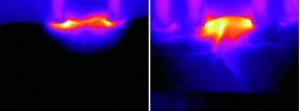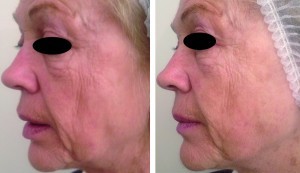Materials and methods
A total of 30 patients (all female, aged 38–76 years, average age 55.96 years) were treated using the EndyMed Pro 3DEEP system. The patients were randomly recruited to the study after they had been given a thorough evaluation and had expressed an interest in joining the study — only after fulfilling the inclusion criteria.
The patients were enrolled in the study after meeting all inclusion/exclusion criteriaand providing signed informed consent forms. Patients’ Fitzpatrick skin types varied between 1 and 4. The main inclusion criteria were healthy patients over 21 years of age with facial conditions as required by the evaluation protocol. It was also necessary for the patient to be able to comprehend and sign informed consent for participation in this study, and commit to all treatments and follow-up visits.

Figure 1 Thermal imaging (ThermaCAM SC 640, FLIR Systems) of bipolar radiofrequency pulse (left) and 3DEEP radiofrequency pulse (right). In both cases, the same energy and pulse duration were used. The comparison shows superficial flow of energy with the bipolar technology, while with the 3DEEP technology a much deeper penetration can be seen. This advantage enables the 3DEEP technology to reduce risks for epidermis and increase efficacy in the deep dermis
The main exclusion criteria were based on the medical/clinical condition and history of the patient. For example, electrical device implant, metal implants in the treatment area, pregnant or lactating women, patients who underwent any other surgical or cosmetic procedure in the recent past, patients with any skin problem or suspicious lesions in the treatment area, and subjects with clotting disorders or any other medical condition that may affect treatment were causes for exclusion from the study.
Treatment
During each treatment session, patients received a full-face and neck 3DEEP non-ablative facial tightening treatment, while the recommended protocol by the company is to divide the cheeks and the neck into two treatment areas. The first four treatment sessions were performed at 2-week intervals, with an additional two treatment sessions performed at 4-week intervals (i.e. patients received six treatment sessions). Patients returned at 1 and 3 months after the sessions for follow-up.

Figure 2 61-year-old female. (left) before treatment and (right) after three treatment sessions. A significant wrinkle reduction can be seen in the perioral and chin area
The RF device used was an EndyMed Pro, a phase-controlled, multisource RF system that emits RF energy at 1 MHz of up to 65 watts. All patients were treated with the small (facial) handpiece.
The non-ablative deep dermal heating mode is painless and therefore, does not require any kind of anaesthesia or post-treatment care. Before commencing the non-ablative procedure, the skin was cleaned with soap and water in order to remove make-up or other lotions. The treatment area (face and neck) was divided into two sections (two sides, approximately 25 x 10 cm). As the treatment area was more than twice the size of the recommended treatment area — according to the treatment protocol of the company — the treatment energy used was the maximum (65 W). Using the maximum energy allowed the operator to maintain the desired skin surface temperature in order to reach the endpoint and trigger collagen remodelling through an effective treatment. Each treatment area was heated for up to 10–15 minutes, during which, skin surface temperature was maintained at 40–42 °C. Treated areas were visually assessed for skin responses, including oedema, erythema, and textural changes following the treatment.
Dedicated questionnaires were used for both doctor and patients in order to grade different parameters, such as efficacy, safety, and comfort of treatment, in addition to subjective satisfaction of the patients. The patient answered the questionnaires at the end of the six sessions, at 1-month and 3-month follow-up. In addition, the physician answered a dedicated questionnaire for each patient.
Clinical improvement in skin laxity and texture was evaluated by the physician. Evaluation of the clinical improvement was based on a scale of improvement.
Results

Figure 3 62-year-old female (left) before treatment and (right) after six treatment sessions. A significant improvement in skin laxity in the lower face and a reduction of wrinkles can be seen
All patients completed six treatment sessions, except for two patients: one who had only five sessions, and one who had eight sessions. The patient who had only five sessions did not attend the sixth appointment owing to personal reasons. The patient who received eight treatments had two shorter than usual sessions (of the standard six), so the physician decided to administer two further treatments for this patient. Fitzpatrick Wrinkle and elastosis Scale (FWS) scores before the treatment sessions ranged between 3 and 8, while FWS after six treatment sessions ranged between 2 and 7. Three months after the end of treatment, the average Fitzpatrick scale decreased by more than one level. All patients except for two had a decrease in Fitzpatrick scale of at least one level. Before and after images can be seen in Figures 2 and 3.



